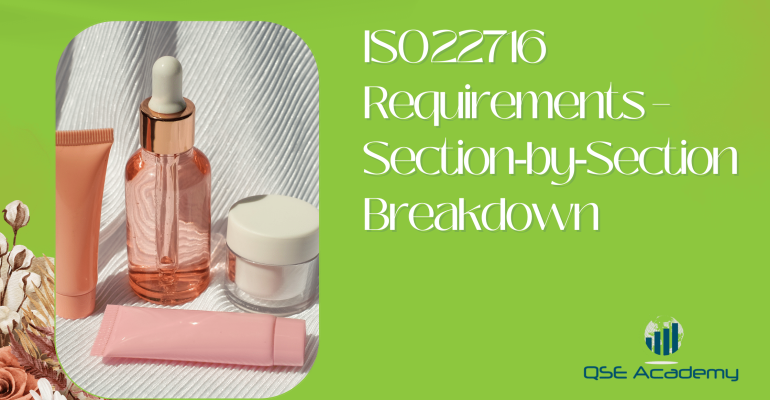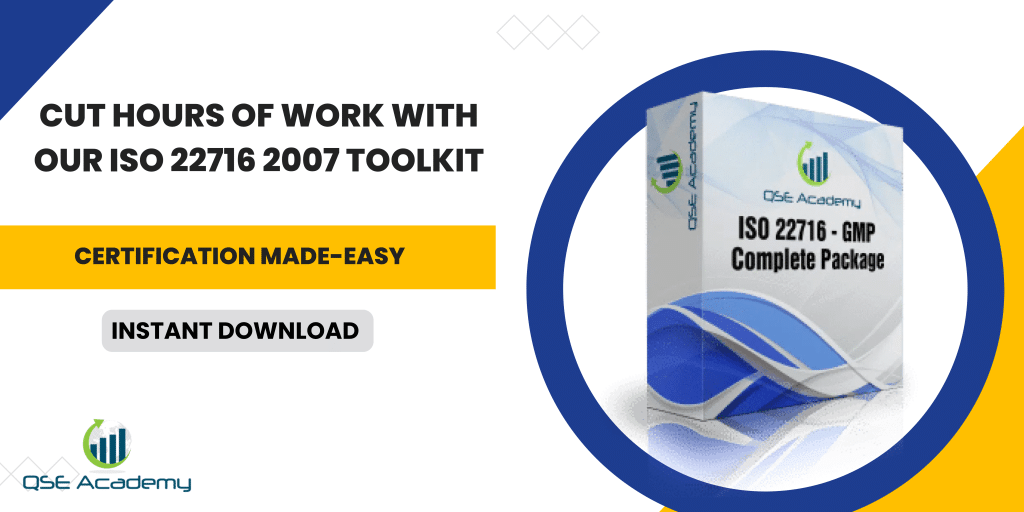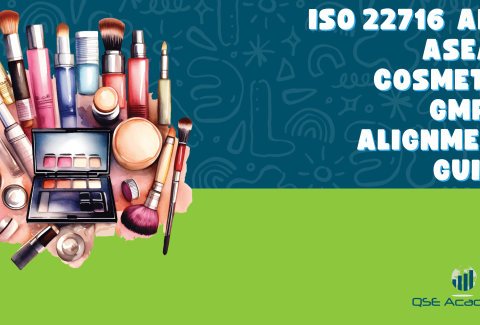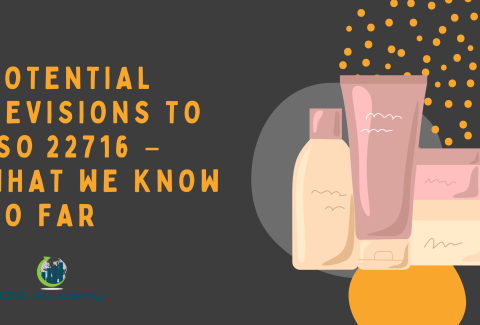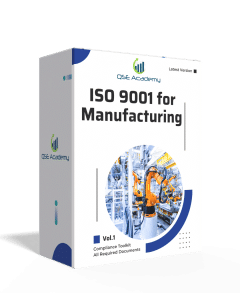ISO 22716 Requirements – Section‑by‑Section Breakdown
Last Updated on October 24, 2025 by Hafsa J.
Understanding the Purpose of ISO 22716
ISO 22716 is the international standard for Good Manufacturing Practices (GMP) in cosmetics. It transforms vague ideas about “quality” into specific, auditable requirements—covering every part of your operation, from personnel and production to laboratories, packaging, and recalls.
For cosmetic manufacturers, it’s not just a certificate on the wall. It’s a blueprint for producing safe, consistent, and compliant products that customers and regulators can trust. The standard ensures that every step—every decision—is traceable and controlled.
This pillar guide breaks ISO 22716 down section by section. You’ll see exactly what each clause requires, how it fits into daily operations, and what practical steps turn compliance into a working system. The goal is clarity: understanding not just what to do, but why it matters.
In my experience helping manufacturers implement ISO 22716 across all scales—from boutique brands to export-ready facilities—the difference between stress and control often comes down to understanding these sections as a connected framework, not a checklist. Once that happens, compliance becomes the natural outcome of well-managed processes.
Scope and Terms – Understanding the Foundation
Before you dive into procedures and documentation, ISO 22716 begins by defining who the standard applies to and how its language should be understood. These early sections are often overlooked, yet they form the base for every GMP decision you’ll make later.
Scope defines the boundaries. ISO 22716 applies to anyone involved in the production, control, storage, and shipment of cosmetic products. That includes manufacturers, subcontractors, packers, warehouses, and distributors. It’s flexible by design—you can tailor how requirements apply depending on your size, complexity, and type of product.
Terms and definitions are your reference point. They establish exactly what ISO 22716 means by words like batch, recall, contamination, deviation, and nonconformity. Using these consistently across your system keeps everyone—from operators to auditors—on the same page.
In practice, this foundation prevents confusion. When staff and management speak the same “GMP language,” decisions become faster, and documentation stays aligned.
Pro Tip:
Create a GMP glossary based on ISO 22716’s definitions and include it in your Quality Manual. It’s a simple step that saves time during training and audits alike.
These first clauses may look theoretical, but they set the tone for everything that follows: clarity, consistency, and shared understanding—three traits every compliant cosmetic facility needs.
Personnel & Premises Requirements
People and space form the backbone of any cosmetic GMP system. ISO 22716 starts its practical requirements here because quality doesn’t begin with a product—it begins with the people making it and the environment they work in.
Personnel requirements center on competence, hygiene, and responsibility. Every role—from operator to quality manager—must have clearly defined duties and documented training. Employees should understand not only how to perform their tasks, but also why they matter for product safety. Personal hygiene, protective clothing, and restricted access are all basic, but they’re what prevent contamination at the source.
Premises requirements focus on control of the physical environment. Facilities must be designed and maintained to prevent cross-contamination, protect raw materials, and support smooth product flow. That means cleanable surfaces, separate zones for different processes, and logical layouts that separate “dirty” from “clean” operations.
Auditors often say they can sense a compliant culture within five minutes of entering a facility. Organized spaces, labeled zones, and confident staff speak louder than any procedure.
Pro Tip:
Link your training matrix and facility layout directly to your Quality Manual. It shows that personnel, hygiene, and premises aren’t separate topics—they’re integrated controls that support every other GMP clause.
When your people are trained, your spaces controlled, and your processes understood, compliance stops being a burden—it becomes how your facility naturally operates.
Equipment Management
In ISO 22716, equipment is more than a set of tools—it’s the foundation of process reliability. Every instrument, mixer, or filling line directly affects product quality, which is why the standard requires that equipment be suitable, maintained, and traceable throughout its life cycle.
Proper equipment management covers four key areas:
-
Selection: Choose equipment designed for cosmetic production—easy to clean, resistant to corrosion, and made from materials that won’t react with your products.
-
Maintenance: Establish cleaning, servicing, and inspection schedules. Keep records of every activity, from calibration to repair.
-
Calibration: Verify measuring devices regularly to ensure accuracy. Document results and clearly label each unit with its calibration status.
-
Traceability: Maintain identification numbers or tags so every piece of equipment can be tracked through maintenance and use.
Well-managed equipment reduces variation, downtime, and the risk of contamination. I’ve seen manufacturers achieve better consistency simply by tightening calibration intervals and assigning ownership for each machine—small steps that make a measurable difference.
Pro Tip:
Develop an Equipment Logbook or Master List that includes ID, location, responsible operator, last maintenance date, and next calibration due. It’s a small effort that auditors see as a big sign of control.
Common Pitfall:
Assuming third-party calibration certificates alone prove compliance. ISO 22716 expects internal verification too—always confirm that instruments perform accurately under your actual conditions.
Reliable equipment builds reliable products. When tools are clean, accurate, and documented, every batch that passes through them carries confidence with it.
Raw Materials, Production & In-Process Control
ISO 22716 puts heavy emphasis on how materials are handled and how processes are controlled. It’s the section that determines whether your finished product is consistent batch after batch—or a gamble.
Raw material control starts the moment ingredients arrive. Each lot must be checked, identified, and released by Quality before use. Materials should be stored under defined conditions, separated by status—approved, quarantined, or rejected. Traceability begins here: you should always be able to link any product back to the specific ingredients that built it.
Production control ensures that approved materials become finished goods through a controlled, repeatable process. Every batch needs a master record describing quantities, sequence, equipment used, and critical parameters like temperature, mixing speed, or pH. Operators record these values in real time, creating the traceable story auditors expect to see.
In-process control is your safety check during manufacturing. Periodic tests—appearance, viscosity, or microbiological screening—verify that the product remains within specification before it reaches the filling line. These checks prevent costly rework later.
Pro Tip:
Use a Batch Manufacturing Record (BMR) template that captures material codes, processing data, and in-process results all in one place. It simplifies review and ensures no detail slips through.
Common Pitfall:
Skipping line clearance or relying on memory for process settings. ISO 22716 expects documented evidence, not assumptions, for every critical step.
When materials, methods, and monitoring align, you create a predictable system. That’s what GMP is about—not hoping for quality, but building it into every action.
Laboratory Controls & Testing
If production is the heart of GMP, laboratory control is its conscience. ISO 22716 requires every cosmetic manufacturer to verify product quality through planned, documented testing that covers raw materials, in-process checks, and finished goods.
A compliant laboratory system ensures that no product is released without evidence that it meets defined specifications. That means clear testing procedures, validated methods, calibrated instruments, and properly trained analysts.
Sampling and testing must follow written instructions. Samples should represent the batch accurately, be handled hygienically, and be labeled with full traceability—product name, lot number, and date. Once tested, results must be reviewed and approved by Quality before release.
Testing also extends to retention samples and stability programs, which confirm that your product performs safely throughout its shelf life.
Pro Tip:
Create a Laboratory Master File summarizing your testing methods, equipment, calibration records, and specifications for all materials and finished products. It’s an excellent reference point during audits.
Common Pitfall:
Treating the lab as a separate entity from production. ISO 22716 expects full integration—your test results should feed back into process adjustments, CAPAs, and continuous improvement.
One well-run lab doesn’t just verify results—it prevents issues. When your laboratory operates with discipline and transparency, your data becomes your strongest defense in every inspection.
Packaging, Labeling & Finished Product Handling
Packaging and labeling are where GMP meets presentation. It’s the final step before your product reaches the market—and where one small error can undo months of controlled work. ISO 22716 dedicates this section to ensuring that every finished product is packaged, labeled, and stored under controlled, documented conditions.
Packaging control begins with approved materials. Containers, caps, and labels should be inspected and stored just like raw materials—with clear identification and traceability. Before each packaging run, the line must be cleared of leftover items from previous batches to avoid mix-ups.
Labeling control is equally critical. Labels must match the approved artwork, contain the correct information, and be applied to the right product. ISO 22716 expects you to have systems in place to prevent and detect label errors—such as pre-run checks, in-process verifications, and documented reconciliation of unused labels.
Finished product handling ensures that goods are stored and distributed in a way that maintains their integrity. Products should be kept in clean, secure areas with temperature and humidity appropriate to their formulation. Quarantined, approved, and rejected stock must always be clearly segregated.
Pro Tip:
Implement a line clearance checklist before and after each batch run. It’s a simple document that prevents the most common GMP issue—label or component mix-ups.
Common Pitfall:
Skipping label verification during rush orders or short runs. Even minor packaging deviations can lead to costly recalls and damaged trust.
Well-managed packaging and storage show that your GMP control doesn’t end at production—it continues until the product safely reaches your customer.
Complaints, Recalls & Change Control
Even with the best systems in place, issues can still happen. ISO 22716 recognizes this and requires every manufacturer to have procedures for handling complaints, recalls, and controlled changes. Together, these form your safety net—the part of your GMP system that proves you can manage problems calmly, consistently, and transparently.
Complaint handling ensures that customer feedback is taken seriously, documented properly, and investigated by Quality. Each complaint should trigger an evaluation, root-cause analysis, and corrective action when needed. The goal isn’t just resolution—it’s prevention.
Recalls are the next level of control. A recall procedure must define how to identify, retrieve, and account for affected products if safety or quality concerns arise. Regular mock recalls test your readiness and verify that traceability truly works.
Change control keeps improvement from turning into risk. Every modification—whether to a formula, packaging, or equipment—must be reviewed and approved before implementation. This ensures that changes don’t unintentionally compromise product quality or regulatory compliance.
Pro Tip:
Link your complaints, recalls, and change control into one CAPA system. When data from all three flow together, you see patterns early and prevent repeated issues before they reach customers.
Common Pitfall:
Making informal adjustments—like switching materials or updating artwork—without documenting the impact assessment. ISO 22716 requires traceable decision-making for every change.
Handled properly, these systems don’t expose weaknesses—they highlight maturity. They show that your company doesn’t hide issues; it manages them responsibly.
Internal Audits & Self-Inspection
A strong GMP system isn’t just built—it’s maintained. ISO 22716 expects manufacturers to confirm that their processes actually work through regular internal audits and self-inspections. These checks ensure that procedures are followed, records are complete, and continuous improvement stays active.
Internal audits are your early-warning system. They identify weaknesses long before an external auditor or regulator ever does. The process should be planned, documented, and objective—covering every function from production and laboratory controls to warehousing and complaint handling.
Here’s what ISO 22716 emphasizes:
-
Defined frequency: Each area should be audited at least annually or more often if risk or past findings justify it.
-
Qualified auditors: The auditor must be independent of the area being reviewed and trained to interpret ISO 22716 requirements correctly.
-
Documented results: Findings, corrective actions, and follow-ups must be recorded and tracked until closure.
-
Verification: CAPAs raised from audit findings should be reviewed for effectiveness.
Pro Tip:
Use an Internal Audit Schedule that maps every process against the year. It demonstrates planning and ensures that no area is overlooked when audit time arrives.
Common Pitfall:
Treating audits as box-ticking exercises or only preparing when certification is near. Real value comes from treating internal audits as opportunities to strengthen—not simply to comply.
When approached this way, self-inspection becomes more than an obligation—it becomes your most reliable tool for keeping your GMP system alive, accurate, and ready for anything.
Documentation & Recordkeeping
In ISO 22716, documentation isn’t paperwork—it’s proof. Every procedure, test, and decision must leave a visible trail that shows your processes are planned, controlled, and repeatable. Without records, even the most disciplined operation can’t demonstrate compliance.
Documentation provides the framework. It defines what should be done, how it should be done, and who is responsible. This includes SOPs, work instructions, quality manuals, forms, and specifications. Each document must be current, reviewed regularly, and approved before use. Outdated versions should be removed from circulation to avoid confusion on the production floor.
Recordkeeping provides the evidence. Batch records, test results, cleaning logs, training files, and calibration reports all confirm that procedures were followed. ISO 22716 expects records to be legible, traceable, and stored securely for the product’s shelf life plus one year—or longer, depending on regulations.
Pro Tip:
Adopt a Document Control Matrix that lists each document’s version, owner, and approval date. It’s one of the simplest ways to show auditors that your system is organized and actively maintained.
Common Pitfall:
Allowing uncontrolled copies of SOPs or labels to circulate in production. Even a single outdated form can raise questions about control—and consistency.
Strong documentation is what turns daily operations into evidence of compliance. When records are accurate, accessible, and well-managed, you don’t just meet ISO 22716—you prove it.
FAQs – ISO 22716 Requirements
Q1: What is the main goal of ISO 22716?
ISO 22716 provides a practical framework for applying Good Manufacturing Practices (GMP) to cosmetic production. Its goal is to ensure products are consistently made, controlled, and stored in conditions that guarantee safety, quality, and traceability.
Q2: Does ISO 22716 apply only to large manufacturers?
No. The standard applies to all cosmetic producers—from small laboratories to global brands. Its principles are scalable, meaning smaller businesses can apply them in simpler, proportionate ways without compromising compliance.
Q3: How is ISO 22716 different from ISO 9001?
ISO 9001 focuses on quality management across any industry, while ISO 22716 applies specifically to cosmetic GMP. It adds detailed operational controls for hygiene, traceability, production, and product safety that go beyond ISO 9001’s generic framework.
Q4: How often should internal audits and reviews be done?
At least once a year, though high-risk or rapidly changing processes may need more frequent checks. The frequency should always reflect your level of activity and the complexity of your operations.
Q5: What documentation is mandatory under ISO 22716?
Key documents include your Quality Manual, SOPs, batch records, cleaning logs, calibration reports, complaint forms, and recall procedures. Each must be version-controlled and accessible to relevant staff.
Key Takeaways and Next Steps
ISO 22716 isn’t just another certification standard—it’s a complete framework for how cosmetics should be made, tested, packaged, and delivered safely. Each section builds on the next, creating a structured system where people, processes, and documentation work together to protect your brand and your customers.
Here’s what to remember:
-
Every clause serves a purpose—none exist in isolation.
-
Compliance depends on control: people, premises, equipment, and records must all align.
-
Traceability is non-negotiable. Every material and decision should lead back to documented proof.
-
Continuous improvement—through CAPA, audits, and change control—keeps your system strong long after certification.
In my experience, successful cosmetic manufacturers don’t view ISO 22716 as a burden; they use it as a management tool. It gives structure to daily operations, improves efficiency, and builds confidence in every product that leaves the facility.
If you’re ready to build that level of control, QSE Academy’s ISO 22716 Documentation Toolkit can help. It includes every template, checklist, and procedure needed to implement the standard section by section—from personnel and laboratory controls to complaint handling and change management.
Take the next step toward full ISO 22716 compliance. Strengthen your GMP system today and turn documentation into your greatest asset.
Whether it’s ISO 9001, ISO 22000, or the cosmetics-focused ISO 22716, I’ve spent my career I’m not here to call myself an expert—I prefer “enthusiast” because I truly love what I do. When I’m not writing about standards, you’ll probably find me playing Piano 🎹, connecting with people, or diving into my next big project💫. I’m an engineer specialized in the food and agricultural industry
make ISO standards less intimidating and more approachable for everyone.
turning complex jargon into clear, actionable steps that businesses can actually use.
There’s something incredibly rewarding about helping people navigate food safety and quality management systems
in a way that feels simple, practical, and even enjoyable.
I have a Master’s in QHSE management and over 12 years of experience as a Quality Manager
I’ve helped more than 15 companies implement ISO 9001, ISO 22000, ISO 22716, GMP, and other standards
My clients include food producers, cosmetics manufacturers, laboratories, and service companies
I believe quality systems should be simple, useful, and efficient.

